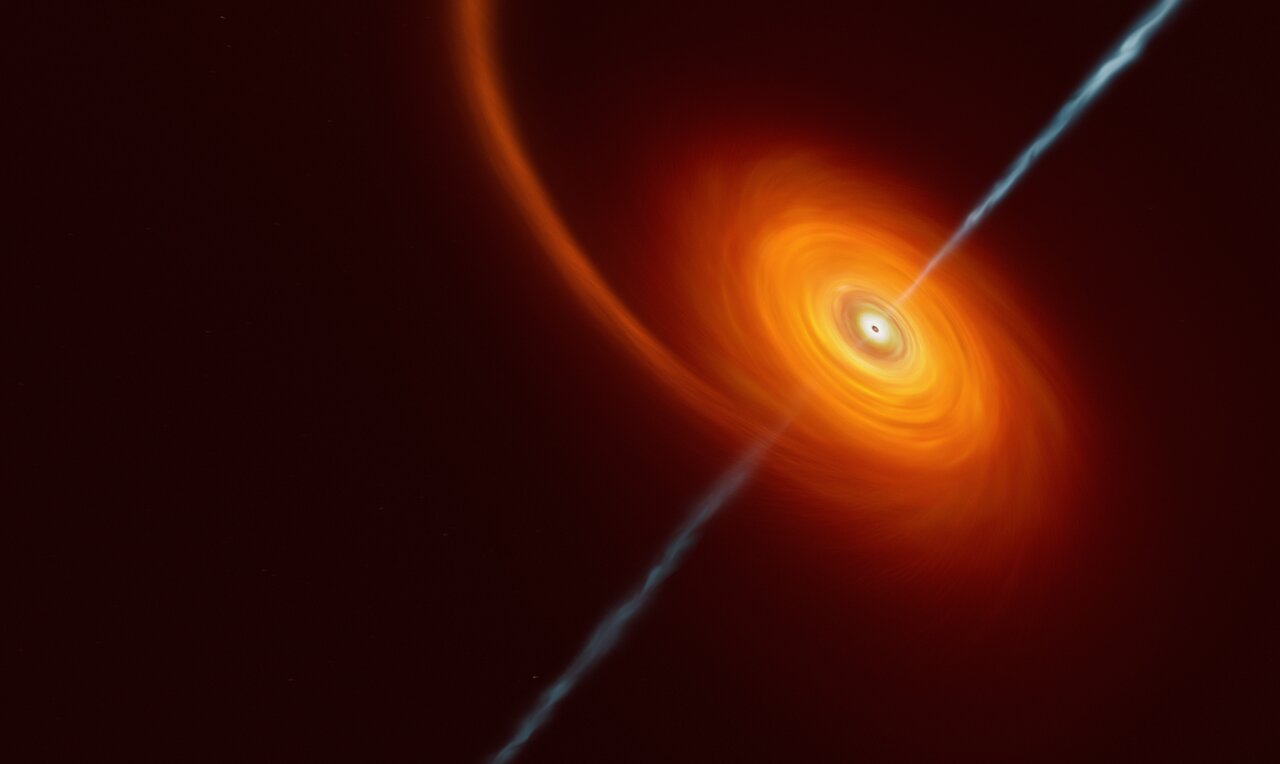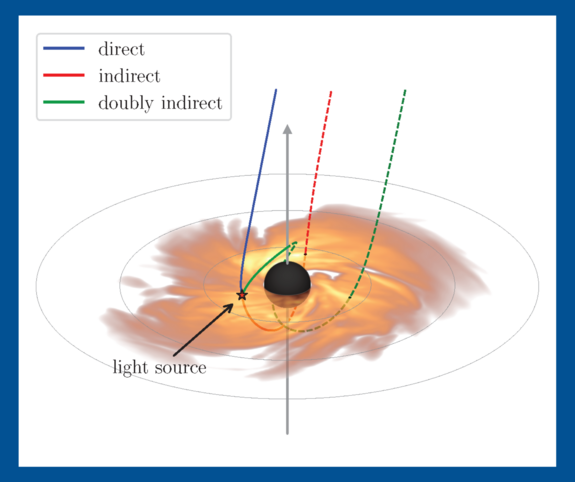A black hole's secrets could hide in its dizzying light 'echoes'
Black hole light echoes are an extreme form of gravitational lensing.

To measure the masses and spins of black holes, scientists want to follow clues left behind by light that takes a round-a-bout journey, bends around these voids, and ultimately shines toward us.
The crew, from the Institute for Advanced Study, Princeton University and Los Alamos National Laboratory, has performed complex computer simulations to show how two telescopes — one on Earth, the other in space — can work together to make the idea a reality. In other words, these devices could help us detect light that has basically been on a trip around a black hole.
The concept is based on a gravitational lens — the ability of a massive object to warp the very fabric of space and time, or spacetime, and therefore alter the path of light. Some black holes are the most massive individual objects in the universe; the black hole at the center of the galaxy Messier 87, for example, has a total mass that's 6.5 billion times greater than the mass of our sun. Such immense, compact objects are able to seriously dent spacetime.
Black holes such as the one in M87 are ringed by disks of hot gas that steadily flow inward toward the maws of the voids. These disks are not placid; they can be tumultuous, with denser clumps within the disks — perhaps a gas cloud or a rogue asteroid — frequently being torn apart by the respective black holes' gravitational tides, releasing bursts of energy and light in all directions. Some of this light shines directly at us, but some initially shines in the opposite direction. However, the path of that light gets caught in the space that is warped by the mass of the black hole itself. The light can actually travel around the black hole, in some cases multiple times, before heading our way. We see this light as a delayed "echo" of the original light burst.
Unlike most gravitational lenses, which magnify the light of more distant objects, in this case the light echo is de-magnified, rotated and sheared, making it pretty faint and astronomers were unsure whether it could be detected.
That could, however, be about to change.
"That light circles around black holes, causing echoes, has been theorized for years, but such echoes have not yet been measured," George Wong of the Institute of Advanced Study and Princeton University said in a statement. "Our method offers a blueprint for making these measurements, which could potentially revolutionize our understanding of black holes."
Get the Space.com Newsletter
Breaking space news, the latest updates on rocket launches, skywatching events and more!

The length of the delay is primarily determined by the mass of the black hole. This is because the more massive a black hole is, the wider its event horizon, and the longer it takes light to circle around it. The inclination of the black hole relative to our viewpoint is also a factor, as different inclinations can lead to different delay times.
Wong's team ran computer models that showed how long baseline interferometry — the process of combining light detected by telescopes in different locations — could distinguish between the direct light and the indirect light echo around a black hole similar to the one in M87. They speculate that it would only require a "modest" space mission working in unison with a telescope already on the ground.
All black holes are characterized by just three parameters: their mass, their spin and their electric charge, which is effectively nil. So, by using light echoes to obtain accurate measures of the mass and spin of a black hole, it would enable giant leaps in both the understanding of black hole science and the study of galaxy evolution.
"Black holes play a significant role in shaping the evolution of the universe," says Wong. "Even though we often focus on how black holes pull things in, they also eject larger amounts of energy into their surroundings. They play a major role in the development of galaxies, affecting how, when and where stars form, and helping to determine how the structure of the galaxy itself evolves. Knowing the distribution of black hole masses and spins, and how the distribution changes over time, greatly enhances our understanding of the universe."
Gravitational lenses are a manifestation of Albert Einstein's theory of general relativity, which describes how mass and energy interact with space and time. The more intense the gravitational field, the more pronounced the effects of general relativity. Tracking the light echoes in such an environment therefore provides the perfect opportunity to test general relativity.
"Using this technique, we might find things that make us think, 'hey this is weird!'" Lia Medeiros, a NASA fellow at Princeton University, said in the statement. "The analysis of such data could help us to verify whether black holes are indeed consistent with general relativity."
Anything that doesn't behave as general relativity predicts could reveal a flaw in Einstein's theory, but don’t hold your breath — after more than a century we haven’t found one yet.
The work was published on Nov. 7 in The Astrophysical Journal Letters.
Join our Space Forums to keep talking space on the latest missions, night sky and more! And if you have a news tip, correction or comment, let us know at: community@space.com.

Keith Cooper is a freelance science journalist and editor in the United Kingdom, and has a degree in physics and astrophysics from the University of Manchester. He's the author of "The Contact Paradox: Challenging Our Assumptions in the Search for Extraterrestrial Intelligence" (Bloomsbury Sigma, 2020) and has written articles on astronomy, space, physics and astrobiology for a multitude of magazines and websites.
NASA spacecraft spots monster black hole bursting with X-rays 'releasing a hundred times more energy than we have seen elsewhere'
Could we use black holes to power future human civilizations? 'There is no limitation to extracting the enormous energy from a rotating black hole'









